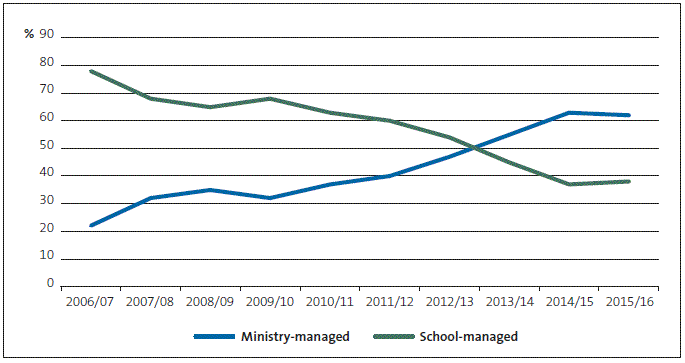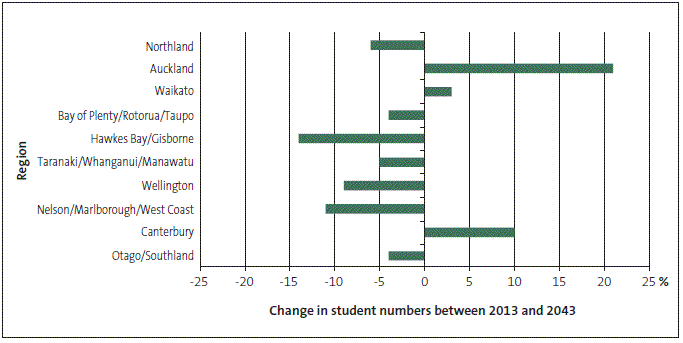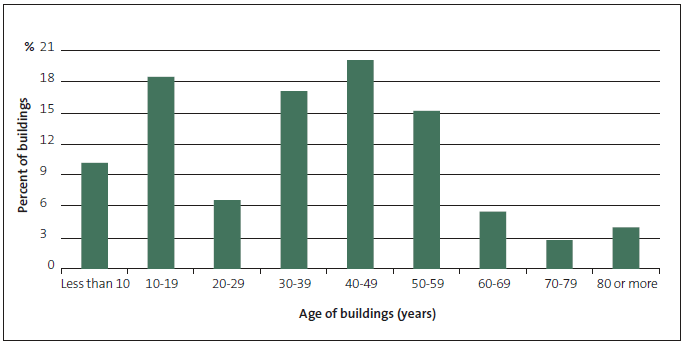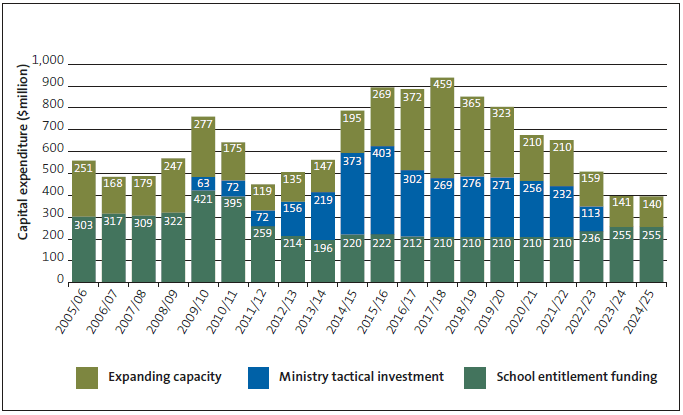Part 2: The school property portfolio
2.1
In this Part, we discuss:
- the nature of the school property portfolio;
- the role of the Ministry;
- how the Ministry funds capital investments;
- how the Ministry manages the school property portfolio;
- the responsibilities of school boards;
- some of the challenges the Ministry faces; and
- Age profile of school buildings.
The nature of the school property portfolio
2.2
In our 2013 report Managing public assets, we define significant assets as those that are important to an entity in delivering its services. The Ministry is listed by the Treasury as a "Tier 1 investment intensive entity".3 Investments by agencies in Tier 1 involve the "commitment of capital or balance sheet resources to the delivery of government services with the expectation of receiving future benefits".4 From an educational perspective, the Ministry funds the capital, or land and buildings, to enable schools to deliver educational services that achieve educational benefits for students.
2.3
As at 30 June 2016, the school property portfolio included more than 2100 operational state schools and was valued at about $14 billion. This includes:
- $4,522 million in land;
- $1,655 million in site improvements, including car parking, drainage, and retaining walls;
- $7,519 million in buildings and services, including plumbing, heating, ventilation, and electrics; and
- $392 million for capital projects not yet completed (excluding public-private partnership assets under construction).
2.4
The school property portfolio includes many small schools. Almost half of the schools in the portfolio have fewer than 200 students, and more than a quarter of schools have fewer than 100 students. Schools with more than 1000 students make up 20% of the total students in all schools, but they represent only 4% of schools.
The Ministry of Education's role
2.5
The Ministry's asset management role is broad and includes:
- calculating and paying operations grants, which includes maintenance funding;
- maintaining core assets' condition and financial information;
- approving school property plans and funding school-led property renewal projects;
- liaising with schools through its network of property advisors;
- forecasting demand growth and decline;
- planning, managing, and funding national programmes, including major redevelopments, extra classrooms needed for increases in student numbers, earthquake-prone building improvements, and new schools; and
- providing training and resources for the school sector.
2.6
The two groups in the Ministry that have the main day-to-day responsibilities for managing school property are:
- Education Infrastructure Services (Infrastructure Services). This group manages the core infrastructure that the Ministry provides for schools – school property, school transport, and school payroll.
- Sector Enablement and Support Group (Sector Support Group). This group supports all schools' operational needs.
2.7
For property matters, the Sector Support Group makes, or supports, all management decisions about where schools are needed throughout the country, with a focus on educational achievement and managing the effect of increase in student numbers and forecast demographic change. The Sector Support Group is involved in all significant property investment decisions.
How the Ministry of Education funds capital investments
2.8
During the year to 30 June 2016, the Crown invested a total of $634 million in the construction, renewal, and redevelopment of assets. The Ministry also gives schools around $76 million in maintenance funding each year as part of their operations grants. This funding is for basic maintenance, such as minor repairs and painting.
2.9
The Ministry gives each school a budget, called the Five-Year Agreement funding, every five years to renew and upgrade existing buildings. The Five-Year Agreement funding is determined by the school's base area.5 The funding calculation does not take account of the condition or the type of materials used in the construction of the school. There is a minimum budget of $45,000 so each school receives at least this much. The Ministry provided about $195 million to all schools as Five-Year Agreement Funding in 2015/16.
2.10
The Ministry has established clear policies and procedures about how this property funding will be provided to, and used by, schools. Five-Year Agreement funding is provided to help achieve longer-term objectives set out in a 10-Year Property Plan. How projects are prioritised is critical to ensuring that schools invest their property funding wisely. We explain this further in paragraph 2.25.
2.11
The Ministry also provides funding to schools where the Five-Year Agreement funding is not enough to resolve property issues. In 2015/16, the Ministry spent about $394 million on these national-funded programmes (often referred to as national interventions). These interventions may be needed because of:
- issues in school property that the Ministry are already aware of, such as weathertightness problems;
- school property needing substantial investment to fix significant issues;
- network or demographic pressure on roll growth and teaching capacity; or
- significant damage from a natural disaster or an event, such as a fire.
2.12
In the last 10 years, capital expenditure in the school sector has grown significantly in response to issues in the current school property portfolio. These issues include the investment needed:
- to repair and rebuild schools in Canterbury;
- to restore school property damaged by weathertightness problems; and
- to respond to the increase in student numbers and movements in population.
2.13
Figure 2 shows how capital expenditure in the year ended 30 June 2016 was divided between funding provided directly to schools (Five-Year Agreement funding) and funding provided to the different national programmes of work. National programmes account for more than 60% of the Ministry's annual capital expenditure.
How the Ministry of Education manages the school property portfolio
2.14
School property management takes place at a local level and a national level. Locally, schools plan for, and manage, capital projects and works funded by the Five-Year Agreement funding. Nationally, the Ministry leads work that is part of national programmes. This work includes interventions to fix asset failure or pro-actively manage major property problems or increases in demand.
Figure 2
How capital expenditure in 2015/2016 is split between funding directly to school and national programmes
| 2016 capital expenditure $million | National programmes | School funding |
|---|---|---|
| Five-Year Agreement | 194.9 | |
| Other existing property | 45.4 | |
| Total maintaining the portfolio | 240.3 | |
| Redevelopments | 83.8 | |
| Weathertightness | 66.6 | |
| Christchurch Schools Rebuild Programme | 89.1 | |
| Total improving the portfolio | 239.5 | |
| Technology in schools | 14.6 | |
| Additional classrooms | 63.8 | |
| New schools | 75.6 | |
| Total expanding the portfolio* | 154.0 | |
| Total capital expenditure | 393.5 | 240.3 |
* Funds provided specifically for expansion, additional to the Ministry's base-line funding for maintaining and improving the portfolio.
Change in roles in the last 10 years
2.15
The Ministry used to fund schools to carry out projects of varying levels of scale. Schools managed significant capital investment or renewal projects as well as projects covered by their Five-Year Agreement funding.
2.16
Since 2006/07, there has been a progressive change in the number of projects that schools are responsible for, compared to those directly managed by the Ministry. Schools are now largely only responsible for managing agreed capital projects funded by their Five-Year Agreement funding. This change was partly because the Ministry needed to respond to the significant challenges of weathertightness problems and earthquake-prone buildings. The Ministry also realised that many projects were too complex, high risk, and capital intensive for school boards, with sometimes limited property skills and capacity, to manage.
2.17
This change has increased the need for the Ministry to work more closely with schools. Figure 3 shows the proportion of Ministry and school-led projects and the significant shift towards Ministry-led projects. As Five-Year Agreement funding has remained relatively static through this period, particularly in the last five years, the main reason for the change is the significant additional expenditure the Ministry has incurred on Ministry-led national interventions.
Figure 3
Proportion of Ministry-led and school-led projects (by value), 2006/07 to 2015/16

Infrastructure Services
2.18
In 2013, after an independent review of school property management, the Minister of Education, with advice from the Ministry, prepared an Eight-Point Plan to transform school property services by setting up Infrastructure Services (see paragraph 2.6). The Ministry's aim was to provide schools with better property services to help improve levels of student achievement and address existing issues affecting school property.
2.19
Infrastructure Services has about 337 full-time equivalent staff with responsibilities for property matters located throughout the country. This is an increase from the 15 staff the Property Management Group had in 2006 when we reviewed the Ministry's management of school property. Figure 4 sets out the main roles and responsibilities for property matters in the Ministry (staff work in Infrastructure Services unless otherwise stated).
Figure 4
Main roles and responsibilities for property matters in the Ministry of Education
| Ministry position | Role |
|---|---|
| Capital works programme managers | Managers of the two capital works programme teams, one based in Auckland and the other based in Wellington to cover all programmes south of Auckland. The managers are responsible for all national programmes, including weathertightness, major redevelopments, and roll growth. |
| National office specialists | National office has a broad range of specialists whose skills include procurement, health and safety, engineering, business case development, assurance, and risk. The main role of the national office specialists are to support the sector, reduce the cost of repetition, and improve the use of good practice throughout the schools sector. |
| Regional-based capital works programme teams | Each capital works programme team has several staff located alongside Ministry staff in the regional offices. These staff interact with schools and regional staff regularly to initiate and complete projects throughout the schools network. |
| Regional managers | There are four Regional Managers throughout the country. They work closely with schools to ensure that funding is used in a way that is consistent with Ministry priorities and are responsible for approving School Property Plans. |
| Regional network staff (in Sector Support Group) | Staff directly responsible for understanding the demand side of the schools network and identifying the most suitable educational outcome. They focus on the needs of the schools in their region with a particular focus on understanding the demographic demands in communities. Regional network staff work with Infrastructure Services to identify the most suitable response to the demand. |
| School property advisors (Ministry advisors) | Ministry Advisors are based in regional offices, and each have between 35 and 55 schools in their portfolio. They are responsible for the day-to-day monitoring of school property, co-ordinating completion of School Property Plans, and assessing whether the Ministry needs to intervene outside projects approved as part of the normal school property planning process. |
| Regional specialists | Each region has specialists focused on co-ordinating broader Ministry resources and supporting Ministry Advisors with schools that have high-risk projects or significant property condition challenges. These staff support schools through all projects, irrespective of how they are funded. |
2.20
Increases in student numbers, new schools, or significant issues with the condition of school property usually result in national interventions. In December 2015, the Ministry established capital works programme teams (based in regional offices) to manage these interventions, as opposed to having them managed by specific programme teams (such as the weathertightness response team).
2.21
The role of the capital works programme teams is to liaise with regional staff to intervene where there are known issues with the condition of school property. This includes extreme cases where, if schools continue to be directly responsible for completing or funding projects, significant property failure could affect the school's ability to teach its students.
2.22
Regionally, Infrastructure Services focuses on ensuring that schools complete their School Property Plans. They achieve this by ensuring that assessments of the condition of school property and the prioritisation of projects is carried out in an effective and timely way. They are also responsible for putting forward investment bids for work thought to be necessary to keep property conditions at an acceptable standard, unless schools have weathertightness problems or earthquake-prone buildings.
The responsibilities of school boards
2.23
School boards are responsible for looking after school property and will often be the first to notice when any issues arise. The Ministry sets out its expectations of schools boards in the Property Occupancy Document in Appendix 2 (the Occupancy Document).
2.24
The Occupancy Document requires each school to prepare a 10-Year Property Plan (School Property Plan) that addresses the school's property needs for the next 10 years. The school appoints a Ministry-approved property planner who updates the information the Ministry holds on the condition of the school property, and then uses this information to prepare the School Property Plan in consultation with the school. However, the school board is ultimately responsible for its School Property Plan and the plan should be consistent with the school charter, which sets out the school's educational goals and strategic plans.
2.25
When the Ministry approves a School Property Plan, it also agrees to specific projects for the next five years. These projects are funded by the school's Five-Year Agreement funding. Representing almost $200 million of the Ministry's capital spending each year, this funding is available to all schools to renew assets and put in place flexible learning spaces. Schools must consider their potential building projects against the following four priorities:
- Health and safety.
- Essential infrastructure work.
- Investing in flexible learning spaces.6
- Other discretionary project(s).
2.26
Schools and the Ministry often challenge each other's views about prioritisation.
2.27
With Ministry approval, school boards can contribute their own funds to supplement their Five-Year Agreement funding. Any assets (or part of an asset) built using these contributed funds will be owned by the school board.
2.28
Five-Year Agreement funding is paid directly to schools, and they manage the approved projects. Although the school can ask the Ministry to manage the projects on its behalf, they usually appoint external project managers to manage the projects for them.
2.29
Figure 5 summarises the roles and responsibilities for managing property in schools.
Figure 5
Roles and responsibilities for managing property matters in schools
| Position | Role |
|---|---|
| School board | School leadership including strategic and property planning, community engagement, and management of community and student stakeholder interests. Specific trustees may be nominated to focus on school property matters. The school board is ultimately responsible for preparing the School Property Plan. |
| School principal | The principal is a member of the board and is also responsible for ensuring that the school follows its Occupancy Document. Principals are usually responsible for day-to-day maintenance of school property. |
| Property planner | External advisors employed by schools to complete a condition assessment of the school's property and prepare the School Property Plan. Property planners need to be pre-approved by the Ministry. They have access to the Ministry's property condition database and are crucial to the integrity of asset condition information and project prioritisation planning. Schools often depend on property planners to take all responsibility for property matters and liaise with the Ministry Advisors, who manage day-to-day property matters. |
| Project manager | Employed by schools to manage one or more school-led property projects. These project managers are now meant to be separate from those preparing the School Property Plans. However, this change has not fully come into effect because of a number of legacy arrangements and that in some locations it is difficult to secure the services of a separate property planner and project manager. |
2.30
Appendix 2 sets out the different roles of schools and the Ministry.
Challenges faced by the Ministry of Education
2.31
Challenges faced by the Ministry in managing the school property portfolio in recent years have included:
- demographic growth in certain main centres, such as Auckland;
- properties with weathertightness problems;
- the implications of new health and safety legislation; and
- the Canterbury earthquakes in September 2010 and February 2011.
2.32
The school property portfolio has seen significant investment in response to these issues, with the Ministry having to improve capability to manage this work. The investment has sought to not simply replace school property, but also improve learning environments.
Increase in student numbers and demographic changes
2.33
One of the Ministry's important responsibilities is managing increases in student numbers and responding to changing trends in demand for schools. Although there is school zoning in many communities, parents' decisions about which school they want their children to attend remains an important factor in changing trends.
2.34
Changing trends have a significant effect on the Ministry's investment decisions. The two opposing demographic drivers affecting the school property portfolio are:
- significant population growth in urban areas, particularly Auckland; and
- declining numbers of students in mainly rural areas, resulting in significant underutilisation of classrooms.
2.35
The Ministry uses several layers of forecasting for population growth. Statistics New Zealand census figures show the forecast total growth in student numbers as 3.8% for 2015-2025. Figure 6 shows the current estimates of growth/decline in student numbers regionally for 2013-2043, using Statistics New Zealand data.
2.36
The demographic trends throughout the country have placed significant pressure on teaching capacity in particular areas. Although population increases in Auckland are well publicised, the Western Bay of Plenty, Hamilton, Queenstown Lakes District, and areas around Christchurch have also had significant increases in student numbers.
2.37
Internal migration is harder to predict than overall population growth. The Ministry can usually manage increased demand for existing schools using non-property measures, such as enrolment zones. However, parents' decisions about which school they want their children to attend means that demand can quickly move from a school that parents perceive as under-achieving.
Figure 6
Estimates of regional changes in student numbers between 2013 and 2043

2.38
The Ministry has a number of choices in response to a growth in demand for schools. As a new school is usually the most expensive choice, the Ministry will consider both property and non-property solutions, such as adjusting enrolment schemes.
2.39
When the Ministry decides that a new school is the solution, it buys land. It will then use information from territorial authorities and developers to work out the property mix in the area, understand the potential age and number of students, and when to begin construction of the school. The timing of the construction of the school is usually the most difficult to predict. There is usually a significant time lag between the land purchase and construction. The cost and availability of construction resources is also currently a challenge for the Ministry.
Age profile of school buildings
2.40
Figure 7 shows the general age profile of school buildings. Because many school buildings were built between the 1950s and 1970s, much of the school property portfolio is reaching a point where it needs significant investment to keep it in a suitable condition for the schools to be able to continue to operate effectively. Many of the properties that are 30-40 years old are in a tired state, and many buildings constructed between 1994 and 2004 have been significantly affected by weathertightness problems.
Figure 7
Age distribution of school buildings

2.41
The age of many of the school buildings means that many teaching spaces do not support modern teaching and learning practices. Most schools were built with a traditional approach to schooling in mind and need to be modified to support modern teaching practices. The Ministry requires schools to consider investing in flexible learning spaces using their Five-Year Agreement funding, after resolving any essential renewal work.
2.42
Although it is not a perfect indication of the level of capital renewal expenditure needed on a portfolio of assets, the Ministry charged $461.5 million in deprecation against school building assets in the year to 30 June 2016. In comparison, $342.1 million was spent on maintaining the school property portfolio and redevelopments. We also note that the $155.7 million spent in 2015/16 on weathertightness problems and on the Christchurch Rebuild Program will also have included some renewal expenditure.
2.43
Forecasts show that significant capital funding is expected to continue. Figure 8 shows the increase in capital investment during the past 10 years and that forecast for the next 10 years. "Ministry Tactical Investment" relates to national programmes such as fixing weathertightness problems and the Christchurch Rebuild Programme, which are expected to be completed in 2023. "Expanding Capacity" also relates to national programmes and includes investment in new schools, buildings, and other infrastructure to meet increased demand. "School Entitlement" covers all property-related funding programmes available to schools (the bulk of this is Five-Year Agreement funding).
Figure 8
Increase in capital spending in the last 10 years and forecast spending in the next 10 years

3: See www.treasury.govt.nz for the list of investment-intensive agencies.
4: Cabinet Office Circular CO (15) 5, Investment Management and Asset Performance in the State Services.
5: Base area is the lesser of (1) the actual area of Ministry-owned buildings at the school; or (2) the area the school is entitled to, based on the number of students on its roll.
6: A flexible learning space focuses on creating teaching spaces that can be easily reconfigured and used in a variety of ways to support different ways of teaching and learning.

